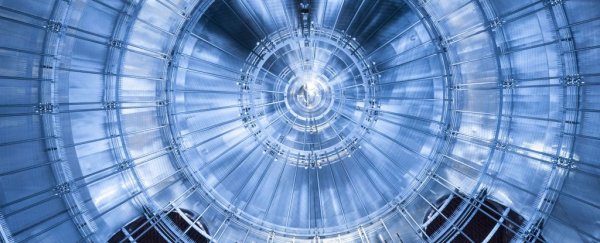Earlier this year, decaying isotopes of hydrogen gave us the smallest measurement yet of the mass of a neutrino.
By measuring the energy distribution of electrons released during the beta decay of tritium, physicists determined that the upper limit for the mass of the electron antineutrino is just 0.8 electronvolts.
That's 1.6 × 10–36 kilograms in metric mass, and very, very freaking small in imperial.
Although we still don't have a precise measurement, narrowing it down brings us closer to understanding these strange particles, the role they play in the Universe, and the impact they could have on our current theories of physics.
The achievement was made at the Karlsruhe Tritium Neutrino Experiment (KATRIN) in Germany.
"The second neutrino-mass measurement campaign of KATRIN, presented here, reached sub-electronvolt sensitivity," the researchers wrote in their paper, published in February 2022.
"Combined with the first campaign, we set an improved upper limit of mν
Neutrinos are very peculiar. They are among the most abundant subatomic particles in the Universe, similar to electrons, but without a charge and almost massless.
This means they interact very rarely with normal matter; in fact, billions are passing through your body right now.
This is why we call them ghost particles. It also makes them incredibly difficult to detect. We do have some methods for detection – such as Cherenkov neutrino detectors – but these are indirect, catching the effects of the passing neutrinos, rather than the neutrinos themselves.
All this means that measuring the near-zero mass of these particles is a particularly tough challenge.
But, if we can obtain a measurement of this property, there will be so much more we can learn about the Universe. Unfortunately, it's also very hard to do. You can't just grab a tiny scale, plop a neutrino on it, and call it a day.
KATRIN leverages the beta decay of an unstable radioactive isotope of hydrogen called tritium to probe the mass of a neutrino. Within the 70-meter (230-foot) chamber, tritium gas decays into helium, an electron and an electron antineutrino, while a huge, sensitive spectrometer probes the results.
Because neutrinos are so ghostly, it's not possible to measure them. But physicists are pretty sure that a particle and its antiparticle have evenly distributed mass and energy; therefore, if you measure the energy of the electrons, you can derive the energy of the neutrino.
This is how the team obtained the upper limit of 1 electronvolt for the mass of the neutrino back in 2019.
To refine that result, the team paired an increase in the number of tritium decays with methods to reduce contamination from other types of radioactive decay, resulting in their refined upper limit.
"This laborious and intricate work was the only way to exclude a systematic bias of our result due to distorting processes," said physicists Magnus Schlösser of the Karlsruhe Institute of Technology and Susanne Mertens of the Max Planck Institute for Physics in Germany.
"We are particularly proud of our analysis team that accepted this huge challenge with great commitment and was successful."
The result marks the first time measurements of a neutrino have fallen below the 1 electronvolt threshold. It's an important result that, while still not quite an exact mass, will allow scientists to refine physical models of the Universe.
Meanwhile, the collaboration is going to continue making attempts to refine measurements of the mass of the neutrino.
"Further measurements of the neutrino mass will continue until the end of 2024," the researchers said.
"To exhaust the full potential of this unique experiment, we will steadily increase the statistics of signal events and continuously develop and install upgrades to further reduce the background rate."
The results have been published in Nature Physics.
A version of this article was first published in February 2022.
